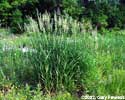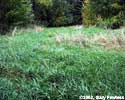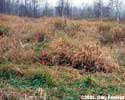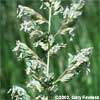
Wetland Plants of Wisconsin
| Phalaris arundinacea L. reed canary-grass Family: Poaceae invasive species |
||||||||||||||||
|
||||||||||||||||
|
Reed Canary Grass is perhaps the worst invasive species in Wisconsin, to date. It forms dense, nearly pure stands that displace all other species from large areas of wetlands, especially sedge meadows. Colonizing plants soon spread by rhizomes to form ever larger clones. When in flower, the branches of the inflorescences tend to spread out and may be any shade of color between medium purple and bright green. After pollination occurs (early June) the branches close back on the central axis to assume the appearance of a spike and the flowers eventually turn to a light tan color and may remain on the stems well into the fall and winter. Leaves often exceed 1 cm in width, broader than virtually all other grasses in our wetlands, except for common reed grass (Phragmites australis). |
|








